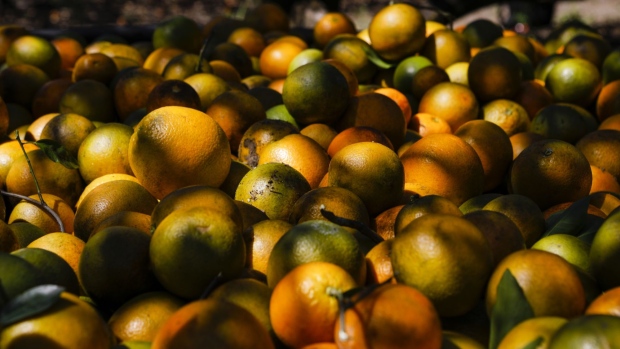Apr 14, 2022
Orange Crop Killer and Frosts Strain World’s Dwindling Juice Supply
, Bloomberg News

(Bloomberg) -- Orange juice stockpiles are dwindling around the world, propelling prices to five-year highs as Florida faces its smallest crop since the Second World War and top citrus producer Brazil grapples with depleted inventory.
Output in the Sunshine State -- the biggest juice supplier in the U.S. -- will tumble 28% this year to 38.2 million boxes, the smallest since 1943. A box weighs 90 pounds (41 kilograms). January’s freezing temperatures weakened groves, adding to lingering impacts from hurricanes, causing citrus trees to drop fruit early while plant disease left behind smaller oranges.
Florida’s woes are “the accumulation of multiple challenges the industry has had over the past few years,” said Shelley Rossetter of the Florida Department of Citrus.
The problems facing orange juice are surfacing as farmers and consumers alike grapple with soaring inflation and rising food prices worldwide, exacerbated by shortages and shipping snags for many agricultural goods. Brazil’s diminished crop, undermined by frosts and drought, and rising transport costs are helping drive a 66% jump in the juice price in the past year.
Frozen orange juice settled at $1.82 a pound Wednesday on ICE Futures U.S. in New York, the highest since March 2017. The price of the popular breakfast staple in U.S. supermarkets rose 7.1% to $7.88 a gallon in late March from a year earlier, according to Nielsen.
The price hikes are raising costs for beverage makers including Minute Maid brand owner Coca-Cola Co. and Paris-based PAI Partners, which owns Tropicana, adding inflationary pressures for consumers when global supplies are getting squeezed.
Prolonged U.S. supply woes and poor Brazilian crops have reduced the global supply of industrialized frozen concentrate juice to around 1.5 million metric tons for the past two years, to approach the lowest levels seen in a decade, according to estimates from Andres Padilla, an analyst at Rabobank International.
Brazil’s frozen orange juice stockpiles are the lowest since 2017, though they are equal to “almost zero” because the juice doesn’t meet industry requirements for acidity and sweetness, according to Ibiapaba Netto, executive director at CitrusBR. The upcoming crop is expected to recover since weather has been favorable, though it won’t be “gigantic” because drought effects will linger for few years, he said.
Crop Disease
Florida’s orange crop is about a quarter of what it was in 2005, when the plant disease known as citrus greening was found in the state’s groves. The disease has steadily destroyed plantings and caused billions of dollars in losses including jobs.
“Greening doesn’t allow trees to endure stress, and we’ve had multiple sources of stress,” said Ray Royce, executive director of the Highlands County Citrus Growers Association in Sebring, Florida. The group, which accounts for about 15% of the state’s crop, will see lower output than expected. He’s “hopeful” that new trees may boost output next year.
Citrus greening has also expanded in Brazilian groves, where crop volume and quality was curbed by frost and drought in 2021-22. The disease has been found in 22% of Brazil’s main producing regions, up from 17% four years earlier, according to Renato Bassanezi, a researcher at Fundecitrus. In some areas, half the plants showed symptoms last year. The disease is expanding because of lack of crop treatments, weather and rising resistance from growers to cut down infected trees that are still producing, he said.
Florida will face difficulties turning around its citrus production, according to Judy Ganes, a consultant who has followed the industry for about three decades. Trees desperately need nutrients and yet fertilizer prices are elevated, and the upcoming hurricane season is expected to bring above average activity, increasing risks for farmers, she said in an interview.
“It will be a tremendous challenge to bring back output,” she said.
©2022 Bloomberg L.P.





